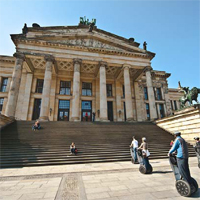Going Round in Circles: Mobility, Destination and Experience
Abstract
This paper addresses the changing approaches to transport in urban tourism as seen through the move from functional sectoral accounts towards a perspective informed by the experience economy. By reviewing the traditional service offers, it is possible to unpack what lies within the service dominant logics that lead to co-creation of value and the realisation of quality tourism experiences. The paper then considers the adoption and adaptation of traditional forms of transport within the value proposition in urban tourism. Mobility in tourism is a strangely new focus of attention, strangely because without it there would be no tourism to speak of. However mobility requires a framework of civil and legal entitlements that allow people to move and a transport infrastructure that allows those rights to be realised in both working and leisure time situations. This article will address the construction of the tourism transport infrastructure by examining the ways in which the transportation elements in mobility have been re-thought within tourism. The first part of the paper will re-construct an account of transport and mobility which deals with it in terms of the functions and logistics of delivery, both between points of origin and destinations, and within destinations. These perspectives can be seen in the texts which shape the basic tourism curriculum and explain how tourism and transport have developed over the years by integrating the opportunities provided by the new technologies – motorised vehicles (both cars and coaches), trains, ships and aeroplanes – to allow for the development of a range of destinations. Lumsdon and Page (2004) introduced a new approach to transport and tourism by distinguishing between transport for tourism and transport as tourism, which provides a linkage between the first and second parts of this article. The second part will develop an account of mobility in tourism that demonstrates how their uniqueness derives from what the ‘Service-dominant (S-D) logic’ would call value cocreation. Hyde and Laesser (2008) emphasised the important role of transport in the tourist decision-making process associated with destination choice behaviour but it is necessary to move beyond this construction of the interconnections. These elements of transport were generally considered to be “goods” or “products” including both tangible and intangible factors. Physical goods become one element among others in a total service offering, from an exhibition to a living performance or a concert and transportation has become an integral part of that experience if not of the offer.Downloads
References
Ács, G. (2007) Fapados forradalom. Budapest Alinea Kiadó,
Andersson, T. D. (2007) “The tourist in the Experience Economy” Scandinavian Journal of Hospitality and Tourism, 7 (1) 46-58
Cooper, C., Fletcher, J. Fyall, A., Gilbert, D., Wanhill, S. (2008) Tourism: Principles and Practice (4th Edition) Harlow, Pearson,
Darmer,P.,Sundbo, J. (2008) Introduction to experience creation in Sundbo, J. and Darmer, P. (eds) (2008) Creating Experiences in the Experience Economy Cheltenham, Edward Elgar
Evans, N. (2003) Strategic alliances in the airline industry. In Evans, N., Campbell, D. and Stonehouse, G. Strategic Management for Travel and Tourism. Oxford: Butterworth-Heinemann
Hodgson, A. (1987) The Travel Industry – Its History pp.1-19. In Hodgson, A. (ed) The Travel and Tourism Industry: Strategies For The Future, Oxford: Pergamon Press,
Hyde, K., Laesser, C. (2008) “A structural theory of the vacation” Tourism Management 30 (2) 240-248
Lumsdon, L., Page, S.J. (2004) Progress in transport and tourism research: Reformulating the transport-tourism interface and future research agendas in Lumsdon, L. and Page, S.J. (eds) Tourism and Transport: Issues and Agenda for the New Millennium. Oxford: Elsevier
Macbeth.J., Carson.D., Northcote.J. (2004) “Social capital, tourism and regional development: SPCC as a basis for innovation and sustainability” Current Issues in Tourism, 7 (6), 502-522.
Magyar Turisztikai Hivatal Hírlevele, 2005. május 13
Page, S. J. (2003) Tourism Management: Managing for Change. Oxford: Butterworth Heinemann
Page, S.J. (2009) Transport and Tourism: Global Perspectives. 3rd edition. Harlow: Prentice Hall,
Pine, J. B., Gilmore, J. H. (1999) The Experience Economy Boston, Harvard Business School Press
Polgár, J. (2008) Vasúti közlekedés Európában in Turizmus Bulletin XII/2.
Percival, J (1987) Railways pp.20-37. In Hodgson, A. (ed) The Travel and Tourism Industry: Strategies For The Future. Oxford: Pergamon Press
Sheth, J., Parvatiyar, A. (2000) “Relationship Marketing in Consumer Markets: antecedents and consequences” in Sheth, J. and
Parvatiyar, A. (eds) Handbook of Relationship Marketing Thousand oak, CA, Sage Publications.
Tynan, C., McKechnie, S. (2009) “Experience Marketing: a review and reassessment” Journal of Marketing Management – Special 25th anniversary edition, 25(5/6): 501-517.
Ullman, E L. (1973) Cities and Society: The Revised Reader in Urban Sociology. New York: Harper and Row
Vargo S.L., Lusch R.F (2004) “Evolving to a New Dominant Logic for Marketing, Journal of Marketing, 68, 1-17.
Vargo S.L., Morgan F.W (2005) “Services in society and academic thought: an historical analysis” Journal of Macro-Marketing, 68, 42-53 (june)
Vargo S.L., Lusch R.F (2008) “Service-Dominant Logic: continuing the evolution” Journal of the Academy of Marketing Science 36: 1-10.

Copyright (c) 2014 Tema. Journal of Land Use, Mobility and Environment

This work is licensed under a Creative Commons Attribution 4.0 International License.
Authors who publish in this journal agree to the following:
1. Authors retain the rights to their work and give in to the journal the right of first publication of the work simultaneously licensed under a Creative Commons License - Attribution that allows others to share the work indicating the authorship and the initial publication in this journal.
2. Authors can adhere to other agreements of non-exclusive license for the distribution of the published version of the work (ex. To deposit it in an institutional repository or to publish it in a monography), provided to indicate that the document was first published in this journal.
3. Authors can distribute their work online (ex. In institutional repositories or in their website) prior to and during the submission process, as it can lead to productive exchanges and it can increase the quotations of the published work (See The Effect of Open Access)
